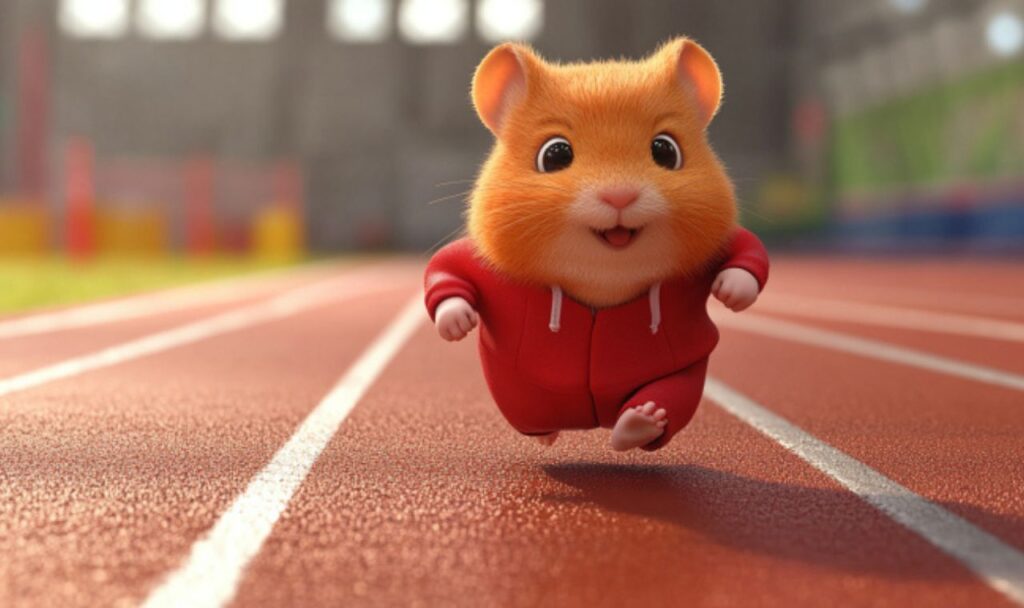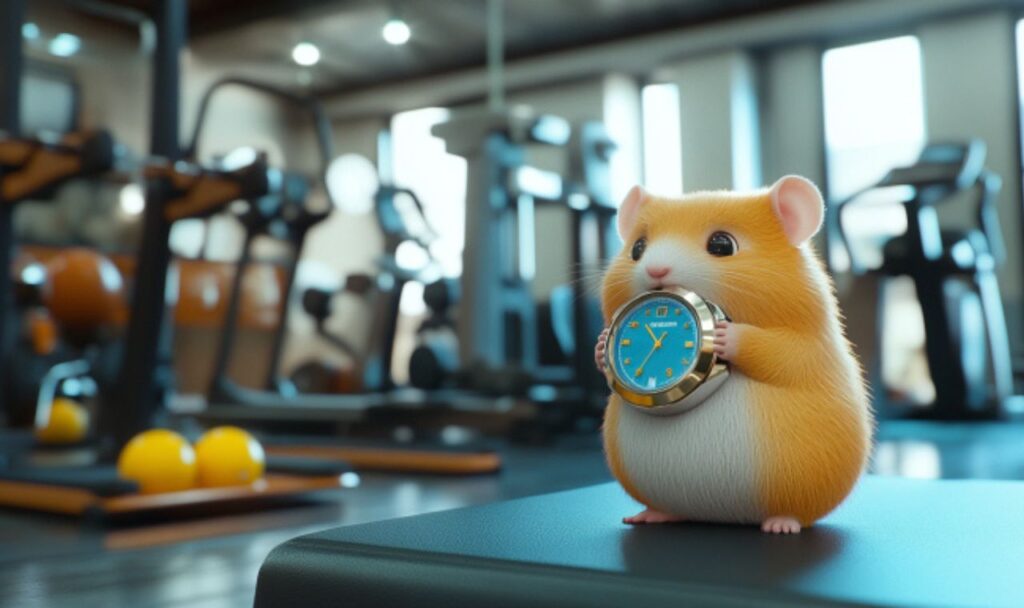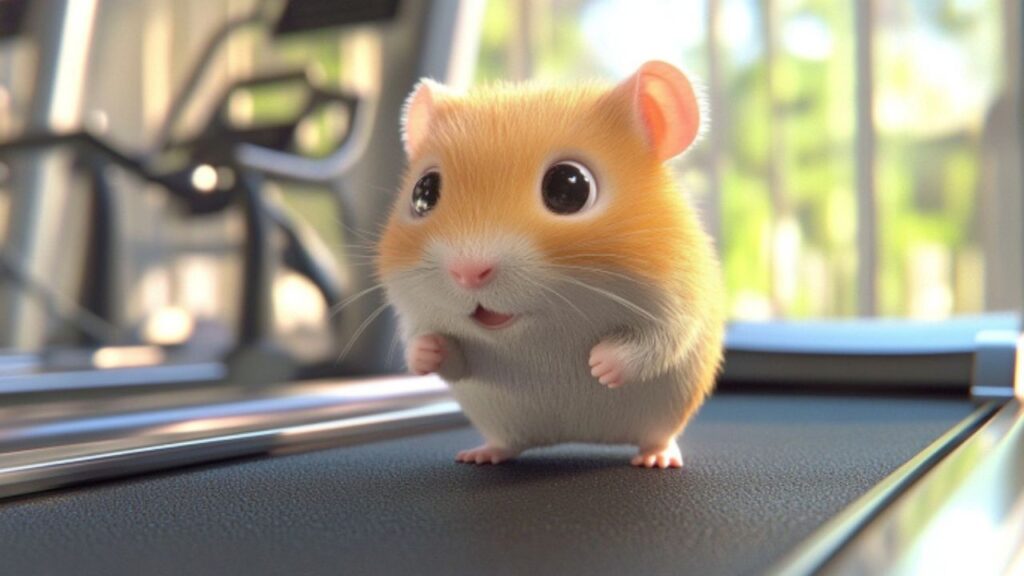Teaching your hamster to sit up on command is one of the cutest and most rewarding tricks you can add to their repertoire. Not only does it showcase their intelligence and charm, but it also strengthens the bond between you and your little fluffball. Training isn’t just fun—it’s enriching for your hamster, giving them much-needed mental stimulation and a chance to shine. Plus, it’s a skill that’s sure to wow your friends and family. Imagine your hamster sitting up on cue during playtime or even posing for adorable photos—talk about a party trick!
Buttons: The Star of the Family
Take Buttons, for example—a spunky Syrian hamster with a big personality and an even bigger appetite for pumpkin seeds. Buttons’ owner, Sophie, decided to teach him to sit up on command after noticing how he naturally lifted his front paws when he smelled treats. Using a simple lure-and-reward method, Sophie spent just five minutes a day working with Buttons. Within a week, Buttons was sitting up on command like a pro, becoming the highlight of every family gathering. Sophie loved seeing Buttons’ confidence grow with each session, and Buttons, well… Buttons loved the extra treats and attention.
Ready to Teach Your Hamster to Sit Up Like the Adorable Genius They Are?
If Buttons can do it, so can your hamster! This step-by-step guide will walk you through the process, from setting up a distraction-free environment to reinforcing the sitting behavior with treats and praise. Let’s get started!
Why Teach Your Hamster to Sit Up on Command?

Training your hamster to sit up on command isn’t just a cute party trick—it’s a meaningful activity that benefits both you and your hamster in a variety of ways. From mental stimulation to strengthening your bond, this trick is a win-win for everyone involved. Let’s explore why teaching your hamster to sit up is so much more than just an adorable skill.
Mental Stimulation: Keep Your Hamster’s Brain Busy
Hamsters might be tiny, but their brains crave activity and enrichment. In the wild, hamsters spend much of their time foraging, digging, and solving problems to survive. In captivity, these natural instincts can lead to boredom and stress if they’re not given enough opportunities to stay engaged. Teaching tricks like sitting up is an excellent way to provide the mental stimulation they need.
- Combat Boredom: Tricks like sitting up mimic problem-solving behaviors by encouraging your hamster to figure out how to achieve a goal (in this case, getting a treat). This keeps their brain active and prevents boredom, which can lead to stress or undesirable habits like excessive chewing or bar-biting.
- Improve Their Well-Being: Scientific studies have shown that mental challenges reduce stress in rodents and improve their overall mental health. By giving your hamster a task to complete, you’re supporting their happiness and creating a healthier, more balanced life for them.
- Channel Their Curiosity: Sitting up on command provides your hamster with a safe, constructive outlet for their natural curiosity. The trick not only stimulates their brain but also gives them a sense of accomplishment with every successful attempt.
When you teach your hamster new tricks, you’re essentially giving them a mental workout that keeps them sharp, happy, and eager for more!
Bonding and Communication
Training is more than just teaching your hamster to perform tricks—it’s about building trust and forming a deeper connection. Positive reinforcement during training sessions helps your hamster see you as a source of fun, safety, and rewards.
- Strengthen Trust: Hamsters are naturally cautious animals, and earning their trust is key to building a strong bond. Training creates positive interactions where your hamster learns to associate your voice, hand movements, and presence with treats and praise. Over time, these moments strengthen the relationship between you and your hamster.
- Foster Communication: When you train your hamster to sit up, you’re teaching them to understand a cue (like “Sit!” or a hand motion) and respond to it. This creates a form of communication between you and your hamster that’s incredibly rewarding for both of you. Your hamster learns to “listen” to you, and you get to witness their intelligence in action.
- Make Yourself the Fun Person: Regular training sessions reinforce the idea that being around you means good things—like treats, games, and praise. Your hamster will start to approach you with excitement, looking forward to those bonding moments.
Every trick you teach becomes a shared experience that builds trust and opens the door to even more interactive playtime with your furry friend.
A Cute Trick with Big Rewards
Let’s be honest—there’s nothing more delightful than watching your hamster sit up like a little acrobat. This trick isn’t just adorable; it’s also surprisingly functional and can add a whole new dimension to your interactions with your pet.
- Practical Benefits: Teaching your hamster to sit up on command can actually make it easier to observe their body for health checks. For instance, you’ll get a clear view of their posture, belly, and paws while they’re sitting upright. It’s a simple yet effective way to ensure they’re healthy without causing them stress.
- Entertainment Value: This trick is bound to be a crowd-pleaser. Imagine your hamster performing for friends and family at a gathering—they’ll instantly become the “talk of the town.” It’s a surefire way to bring smiles to everyone’s faces and show off your hamster’s intelligence.
- Confidence Booster for Your Hamster: Successfully learning a trick boosts your hamster’s confidence. They’ll enjoy the process of figuring it out and the rewards that come with it, making training a positive and enriching experience.
Add a little humor to the mix, and you’ve got yourself a star! Your hamster might not know they’re impressing your friends, but their confident little stance will certainly make them look like they do. Whether it’s for a practical purpose or pure fun, teaching your hamster to sit up on command is as rewarding as it is entertaining.
Setting Up for Success: Essentials Before You Begin

Before you start teaching your hamster to sit up on command, it’s important to create the right environment, choose the best treats, and work within your hamster’s natural schedule. A little preparation goes a long way in making training sessions effective, enjoyable, and stress-free for both you and your furry friend. Here’s how to set the stage for success:
Create the Perfect Training Environment
Hamsters are sensitive creatures, and their training environment plays a big role in how well they can focus and learn. A safe, quiet, and stable space will help your hamster feel comfortable and confident during each session.
- Choose a Quiet, Distraction-Free Spot:
Hamsters can easily become startled by loud noises or sudden movements, so pick a space where they won’t be disturbed. A quiet room away from TVs, pets, and general household activity is ideal. This helps them focus on you and the training task instead of being distracted by their surroundings. - Provide a Flat and Stable Surface:
Use a sturdy, non-slippery surface like a table, desk, or inside their playpen for training. A flat surface ensures your hamster can balance properly when sitting up without wobbling or slipping. For added traction, place a soft cloth, mat, or fleece liner on the surface. This prevents them from feeling uneasy while attempting the sitting position. - Minimize Escape Risks:
If your hamster is an adventurous type, use an enclosed area like a playpen or a large bin to keep them safely contained during training. This allows them to explore and engage without the risk of wandering off mid-session.
By creating a safe and structured training space, you’re setting your hamster up for a stress-free and focused learning experience.
Treats Are the Key to Training Success
If there’s one thing hamsters love, it’s snacks! Treats are the foundation of positive reinforcement training, and choosing the right ones will make all the difference in motivating your hamster to learn.
- Use Hamster-Safe Treats:
Offer small, bite-sized rewards that are safe and easy for your hamster to handle. Popular choices include:- Sunflower seeds (unsalted): A classic hamster favorite.
- Millet: Tiny, easy-to-eat grains that are perfect for quick rewards.
- Fresh vegetables: Small pieces of cucumber, broccoli, or carrot.
- Specialty treats: Store-bought hamster treats made from healthy ingredients.
- Choose High-Value Treats:
Not all treats are created equal in your hamster’s eyes. High-value treats—those your hamster absolutely loves—will grab their attention and keep them motivated. Experiment with different options to see what your hamster prefers, and reserve these special treats exclusively for training sessions to make them extra rewarding. - Keep Portions Tiny:
Since hamsters have small stomachs, use tiny portions to avoid overfeeding. This ensures your hamster stays excited for treats without filling up too quickly.
Treats aren’t just rewards—they’re your hamster’s way of knowing they’ve done something right. The more they associate training with tasty snacks, the more engaged and enthusiastic they’ll be.
Timing Is Everything
Hamsters are crepuscular, meaning they’re naturally most active during the early morning and evening hours. Timing your training sessions to match their energy levels will ensure your hamster is alert, motivated, and ready to learn.
- Train During Active Hours:
Pay attention to your hamster’s natural rhythm. Most hamsters are groggy and disinterested during the daytime, so try scheduling training sessions when they’re naturally awake and curious—typically in the early morning or evening. - Short and Sweet Sessions:
Hamsters have short attention spans, so keep training sessions brief—no longer than 5–10 minutes at a time. Longer sessions can lead to boredom or frustration, reducing the effectiveness of training. If your hamster seems engaged and eager, you can do multiple short sessions throughout the day. - Watch for Energy Levels:
If your hamster seems lethargic, uninterested, or preoccupied during a session, it’s best to stop and try again later. Forcing training when they’re not in the mood can lead to stress and make them less willing to participate in the future.
By aligning training sessions with your hamster’s natural schedule and keeping them short and engaging, you’ll make the process fun and productive for both of you.
The Step-by-Step Guide to Teach Sitting Up on Command

Teaching your hamster to sit up on command is a fun and straightforward trick that relies on patience, consistency, and positive reinforcement. By breaking it down into simple steps, you’ll help your furry friend associate your cues with the sitting action, making training enjoyable for both of you. Let’s dive into the step-by-step guide!
Step 1: Get Their Attention
The first step to teaching any trick is grabbing your hamster’s attention. If they’re not focused on you, they won’t be able to understand what you’re asking them to do. This step is all about establishing a connection and building curiosity.
- Sit in Front of Your Hamster:
Position yourself at eye level with your hamster by sitting in front of their playpen, on the floor, or at a table. This makes it easier for your hamster to see and engage with you. - Use a Favorite Treat as Motivation:
Hold a high-value treat (like a sunflower seed or a tiny piece of cucumber) in your hand. Wave it gently or hold it near their nose to catch their attention. If your hamster shows interest, reward them immediately with the treat and some verbal praise. - Reward for Engagement:
At this stage, you’re not asking your hamster to perform any specific action—just engaging with you is enough. Reward behaviors like sniffing your hand, following the treat with their nose, or even standing still and looking at you. These small steps build focus and create a positive association with the training session.
Pro Tip: If your hamster seems distracted or uninterested, try training at a different time of day when they’re more alert (morning or evening). Additionally, make sure you’re in a quiet environment with no distractions.
Once your hamster is actively paying attention to you, you’re ready to move on to the next step.
Step 2: Lure Them into the Sitting Position
Now that you’ve got your hamster’s attention, it’s time to teach them the actual sitting action. Hamsters often naturally sit up on their hind legs when they’re curious or reaching for something, so this step builds on a behavior they already know.
- Hold the Treat Slightly Above Their Head:
Take your hamster’s favorite treat and hold it just above their head and slightly out of reach. This positioning will encourage them to lift their front paws off the ground and sit back on their hind legs to reach the treat. - Watch for the Sitting Motion:
As soon as your hamster leans back and sits up, immediately reward them by giving them the treat and saying a verbal cue, like “Sit!” Use a cheerful tone to make the cue clear and positive. Timing is crucial here—reward them the moment they perform the desired action so they can associate sitting up with the treat and the verbal cue. - Keep It Fun and Encouraging:
If your hamster seems hesitant, you can move the treat a bit closer to make it easier for them to reach. Celebrate every attempt, even if they don’t fully sit up at first. For example, if they lift one paw or partially sit back, reward them for trying.
Pro Tip: Avoid holding the treat too high, as this might make your hamster overbalance or feel unsure. Keep it just high enough to encourage the sitting motion without causing frustration.
Repeat this process a few times during the session so your hamster starts to associate the verbal cue and the sitting action with a reward.
Step 3: Reinforce the Behavior
Once your hamster begins to understand the connection between the verbal cue, the action, and the reward, it’s time to reinforce and refine their new skill. Repetition is the key to solidifying the trick.
- Repeat the Process:
During each training session, repeat the “lure, sit, reward” process several times. Consistency helps your hamster learn that sitting up leads to treats and praise. - Gradually Add the Cue:
As your hamster becomes more comfortable with the sitting motion, start introducing the verbal cue (“Sit!”) a split second before they sit up. This helps them associate the word with the action. Over time, they’ll start responding to the cue alone. - Phase Out the Lure:
Once your hamster consistently sits up in response to the verbal cue, you can begin phasing out the treat-luring motion. Instead of holding the treat above their head, say the cue and wait for them to perform the action. When they do, reward them with a treat from your other hand. This transition helps your hamster rely on the cue rather than the physical motion. - Reward Intermittently:
After your hamster has mastered the trick, you don’t need to reward them with a treat every single time. Switch to intermittent rewards—sometimes giving a treat, sometimes just offering verbal praise or a gentle stroke. This keeps the behavior consistent while preventing overfeeding.
Pro Tip: Be patient during this phase! Some hamsters might take longer to connect the verbal cue with the action, but with consistent practice, they’ll get there.
How Long Does It Take to Teach This Trick?

One of the most common questions hamster owners ask when training is, “How long will it take?” The answer largely depends on your hamster’s unique personality, past training experiences, and your consistency as a trainer. While every hamster learns at their own pace, most can master the “sit up” trick in 1–2 weeks with daily practice. Let’s explore the factors that influence learning speed, what you can expect during training, and why it’s so important to celebrate progress along the way.
Factors That Affect Learning Speed
Every hamster is different, and their learning speed is influenced by several factors. Understanding these factors can help you adjust your training approach to meet your hamster’s needs.
Temperament
- Curious and Food-Motivated Hamsters:
Hamsters with naturally curious personalities and a strong love for treats tend to pick up tricks faster. These adventurous little fluffballs are eager to explore new challenges, especially when there’s a tasty reward involved. - Shy or Cautious Hamsters:
If your hamster is more reserved or hesitant around new objects, they may need extra time to feel comfortable and confident during training. That’s perfectly okay! Patience and positive reinforcement are key to helping shy hamsters come out of their shells.
Experience
- Seasoned Learners:
Hamsters who have been trained before may understand the process of connecting a cue with an action and a reward. These “experienced students” often pick up new tricks more quickly because they already know the basics of training. - First-Time Trainees:
If this is your hamster’s first trick, they might need more time to understand the process. Teaching them to associate your verbal cues and hand motions with rewards is a new concept, but with consistent practice, they’ll get the hang of it.
Your Training Style
- Consistency is essential! Daily, short sessions (5–10 minutes) at the same time each day will help reinforce the behavior and speed up the learning process.
- High-value treats, clear verbal cues, and a distraction-free environment all play a role in how quickly your hamster learns.
By understanding your hamster’s unique temperament and experience level, you can adjust your training approach to help them succeed at their own pace.
Typical Timeline
For most hamsters, learning to sit up on command takes about 1–2 weeks of consistent practice. Here’s a general timeline of what you can expect:
- Days 1–3:
Your hamster will spend these early sessions learning to engage with you and the treat. They might sniff the treat, follow your hand, and start associating the reward with the action you’re encouraging. You may see small attempts, like lifting one paw or leaning back slightly. - Days 4–7:
By the end of the first week, many hamsters begin to sit up fully when prompted with a treat held above their head. They may not respond to verbal cues yet, but they’re starting to understand the connection between their action and the reward. - Weeks 2–3:
With consistent practice, most hamsters will respond to the verbal cue without needing a treat as a lure. You can start phasing out the treat motion and rewarding only after they complete the action. At this stage, your hamster has likely mastered the trick!
Anecdote: Buttons the Beginner Hamster
Let’s take a moment to celebrate Buttons, a Syrian hamster who became a “sitting-up superstar” in just one week. Buttons’ owner, Sophie, noticed that he loved pumpkin seeds above all other treats. She used these as a high-value reward during training sessions and kept the process simple and fun. On Day 1, Buttons was hesitant and only sniffed the treat. By Day 3, he was sitting up halfway, balancing on his back legs to reach the reward. By the end of the week, Buttons confidently sat up on command, charming his entire family with his adorable new skill.
Buttons’ story highlights the power of using your hamster’s favorite treat, keeping sessions short, and celebrating every small step. If Buttons can do it, your hamster can too!
Celebrate Small Wins
When it comes to training, progress is more important than perfection. Every small step your hamster takes toward learning the trick is worth celebrating—and rewarding!
Why Small Wins Matter:
- Builds Confidence:
Hamsters, like people, gain confidence when their efforts are rewarded. If your hamster partially sits up, lifts their paws, or even just follows your hand with their nose, they’re trying—and that effort deserves a reward. - Encourages Learning:
Reinforcing even the smallest attempts keeps your hamster motivated and engaged. It shows them that they’re on the right track, which encourages them to keep trying.
How to Celebrate Progress:
- Use verbal praise (e.g., “Good job!” in a happy tone) and treats to reward small attempts.
- Keep sessions upbeat and positive, even if your hamster doesn’t perform perfectly every time.
Over time, these small wins add up, and your hamster will progress from partial attempts to confidently sitting up on command. By focusing on and celebrating their progress, you’ll make training a joyful experience for both of you.
Hannah’s Training Tactics: Quick Tips for Success

Training your hamster to sit up on command doesn’t have to be complicated. With a few simple strategies, you can make the process smooth, fun, and rewarding for both you and your furry friend. Here are three quick tips that will help you achieve success while keeping your hamster happy and engaged throughout the journey.
1. Start Low and Slow
The key to teaching your hamster to sit up is to make the process as easy and natural for them as possible. Many hamsters will instinctively sit back on their hind legs to reach for a treat, but positioning the treat just right ensures they can do so comfortably and confidently.
- Hold the Treat Just Above Their Head:
When luring your hamster into the sitting position, hold the treat slightly above their head and close enough for them to feel like they can reach it without stretching too much. If you hold it too high, they may overbalance or feel frustrated, which could discourage them from trying again. - Encourage Gentle Movement:
The goal is to guide them into the sitting position without forcing them. If your hamster leans back slightly or lifts one paw, that’s progress! Gradually adjust the treat placement until they’re able to fully sit up on their hind legs. - Use a Flat, Stable Surface:
A solid surface like a table or the floor ensures that your hamster has the stability they need to balance while sitting up. Soft bedding or slippery surfaces may make it harder for them to find their footing, so choose a spot where they feel secure.
2. Consistency Matters
When it comes to training, consistency is your best friend. Hamsters are creatures of habit, and establishing a regular training routine helps them learn faster and stay focused. Here’s how to make consistency work for you:
- Train at the Same Time Every Day:
Choose a time when your hamster is naturally active, such as early morning or evening, and stick to it. Hamsters are crepuscular, meaning they’re most alert during these hours. A consistent schedule helps your hamster know when it’s “training time,” making them more likely to engage. - Short and Sweet Sessions:
Keep each training session between 5–10 minutes. Hamsters have short attention spans, and shorter sessions ensure they stay focused and excited rather than bored or frustrated. Multiple short sessions throughout the day can also be more effective than one long session. - Repeat the Steps Daily:
Repetition is the key to helping your hamster understand what you’re asking them to do. Practice the same steps—luring them into position, using the verbal cue, and rewarding them—until they start responding automatically.
3. Reward Generously
Positive reinforcement is the cornerstone of hamster training, and rewards are what keep your furry friend motivated and engaged. Treats, praise, and encouragement all play a big role in reinforcing the behavior you’re teaching.
- Use High-Value Treats:
Choose treats that your hamster loves, like sunflower seeds, millet, or small pieces of fresh vegetables (such as cucumber or carrot). High-value treats are extra motivating and will help grab your hamster’s attention during training. - Reward Immediately:
Timing is everything when it comes to reinforcement. As soon as your hamster sits up, reward them with a treat and verbal praise. This immediate feedback helps them understand that the sitting motion is what earns the reward. - Praise and Encourage:
Along with treats, use a cheerful tone to praise your hamster (e.g., “Good job, Peanut!”). Hamsters may not understand your words, but they can pick up on your positive tone, which helps build trust and confidence. - Celebrate Small Wins:
Even if your hamster doesn’t fully sit up at first, reward their efforts. For example, if they lift one paw or lean back slightly, they’re still trying—and that deserves recognition! Each small success brings them closer to mastering the trick.
Conclusion

Teaching your hamster to sit up on command is so much more than just teaching a cute trick—it’s a shared journey that benefits both you and your furry friend in ways you might not expect. For your hamster, it’s an opportunity to exercise their mind, practice problem-solving, and gain confidence as they master a new skill. For you, it’s a chance to bond with your hamster, celebrate their unique personality, and enjoy the pure joy of seeing their tiny “aha” moments when they figure it out.
This trick is as rewarding as it is adorable. Every session spent training builds trust and strengthens your connection with your hamster, reminding them that you’re not just their caregiver—you’re their teammate and biggest cheerleader. From their first hesitant lift onto their back legs to confidently sitting up on command, you’ll share countless moments of pride and laughter along the way. These are the memories that make hamster ownership so special.
And here’s the best part: sitting up on command is just the beginning of what you can achieve together! Once your hamster masters this trick, the possibilities are endless. You can move on to teaching them to stand on command, spin in a circle, or even navigate a mini obstacle course. Each new trick adds another layer of fun and enrichment to your hamster’s life, deepening the bond you share.
Have you and your hamster mastered the sit-up trick? Did your hamster put their own unique spin on the training process? We’d love to hear all about it! Share your stories, photos, and videos with the Hamsters.club community so we can celebrate your progress together. Your experiences might inspire other hamster owners to try new tricks with their pets, too!
With paws and patience, you’re on the road to being a Hamster Whisperer. Happy training!




